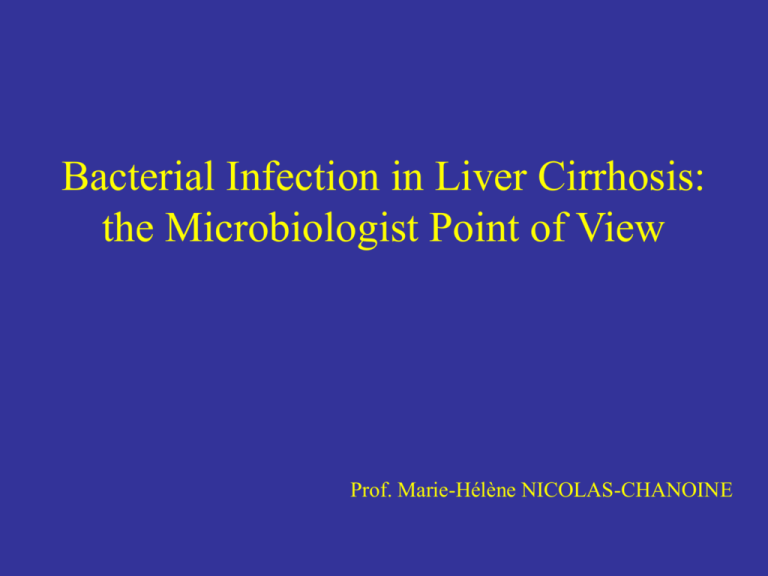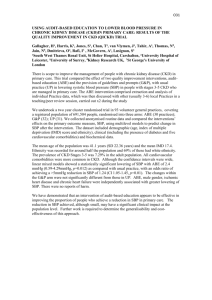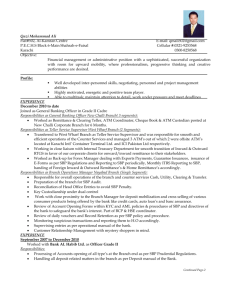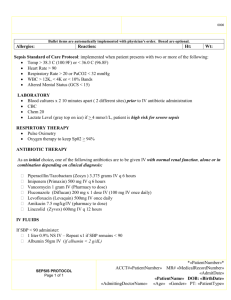Bacterial Infection in Liver Cirrhosis, the Microbiologist Point of View
advertisement

Bacterial Infection in Liver Cirrhosis: the Microbiologist Point of View Prof. Marie-Hélène NICOLAS-CHANOINE Bacterial infections life-threatening complications in cirrhotic patients and common 30 to 50 % of hospitalized cirrhotic patients are concerned by bacterial infections Spontaneous Bacterial Peritonitis (SBP) (± bacteremia) Urinary Tract Infection (UTI) (± bacteremia) Pulmonary infection Others (peritoneal tuberculosis) 25 % of death directly due to bacterial infection Host risk factors for SBP • Surviving to a previous SBP episode • Low ascitic fluid protein levels (<10g/L) • Gastrointestinal hemorrhage Physiopathology of SBP SBP is caused by intestinal micro-organisms that translocate through the mucosal barrier to the mesenteric lymph nodes , enter the bloodstream and reach the ascitic fluid. Bacterial species isolated from AF obtained from patients with SBP and hospitalized in Beaujon hospital (1998-2007) Parameter Number (%) Community Nosocomial Total Episode number 128 69 197 Isolate number 130 74 204 Plurimicrobial 2 5 7 (3.5) Enterobacteriacae 67 43 110 61 (47) 27 (36) 88 (43) Klebsiella spp 2 6 8 Others 4 10 14 Streptococci 52 (40) 15 (20) 67 (32) Viridans group 27 11 38 S. bovis 9 2 11 Pneumococci 7 2 9 B group 8 0 8 S. aureus 2 5 7 Enterococcus spp 1 5 6 (3) Others 7 3 10 Candida 2 3 5 (2.5) E.coli Are bacterial factors involved in morbidity or/and mortality in cirrhotic patients with SBP? “Genetic background of Escherichia coli isolates from patients with spontaneous bacterial peritonitis: relationship with host factors and prognosis”. F. Bert et al, Clin. Microbiol. Infect. (in press) Population structure of E. coli - 4 phylogenetic groups: A, B1, B2 and D - extraintestinal pathogens: more often group B2 isolates - virulence factors (VF)-encoding genes - group B2 isolates have more VF genes than non B2 group isolates Prevalence of virulence factor (VF) genes according to phylogenetic groups in 76 E. coli isolates from patients with SBP (1998-2005) VF gene Prevalence of VF gene, No. (%) of isolates Group A (n=20) Group B1 (n=3) Group B2 (n=35) Group D (n=18) Total (n=76) Adhesins papC 7 (35) 0 26 (74) 6 (33) 39 (51) papG allele II 0 0 15 (43) 6 (33) 21 (28) papG allele III 0 0 11 (31) 0 11 (14) sfa/foc 0 0 18 (51) 0 18 (24) hly 0 0 18 (51) 1 (5.6) 19 (25) cnf1 0 0 17 (49) 0 17 (22) fyuA 8 (40) 1 (33) 35 (100) 11 (61) 55 (72) aer 10 (50) 2 (66) 19 (54) 12 (67) 43 (56) Toxins Siderophores Mean VF score of B2 versus non B2: 15.4 vs 7.3 p<10-4 Comparison of host factors in patients with B2 isolates and those with non-B2 isolates. Value in the indicated group* Variable Patients with B2 isolates (n= 35) Patients with non-B2 isolates (n= 41) P Age (year) 55 55 NS Male gender 26 (75) 34 (83) NS Alcoholism 22 (65) 25 (64) NS Viral hepatitis 8 (24) 11 (28) NS Hepatocellular carcinoma 7 (20) 4 (10) NS Previous SBP episode 2 (6) 12 (30) 0.0153 Norfloxacin prophylaxis 1 (3) 9 (22) 0.0172 26 29 0.1953 Blood neutrophils (cells/mm3) 10,752 7,931 NS Platelet (cells/m3) 136,828 100,049 0.0823 Prothrombin ratio (%) 40 33 0.0558 Serum bilirubin (μmol/L) 200 178 NS Serum creatinine (μmol/L) 142 182 NS Serum sodium (μmol/L) 131 132 NS 4,389 4,501 NS 11 10 0.1100 Hospital-acquired SBP 11 (31) 16 (39) NS Positive blood cultures 9 (26) 15 (37) 0.1487 MELD score AF neutrophils (cells/mm3) AF protein (g/L) * data are no (%) of patients or mean value ; NS, non significant (p ≥ 0.2) ; SBP, spontaneous bacterial peritonitis AF, ascitic fluid, red indicates host factors independently associated with non-B2 isolates 10/76 (13%) patients with fluoroquinolone prophylaxis Prevalence of fluoroquinolone resistance in the 76 SBP E. coli = 16% Fluorouinolone resistance significantly higher in patients with norfloxacin prophylaxis than in those without :70% vs 7.6%, p <10-4 Fluoroquinolone resistance significantly higher in non B2 isolates than in B2 isolates: 30% vs 0% , p <0.001 Overall, we found that the prevalence of non B2 isolates (fewer VF and more often resistant) increased with the severity of liver disease Multiple logistic regression of risk factors for in-hospital mortality1 Variable OR CI 95 % P MELD score 1.832 1.29 – 2.59 0.0007 Hospital-acquired SBP 4.13 1.20 – 14.21 0.0247 Prothrombin ratio 1.513 1.02 – 14.05 0.0412 Serum creatinine level 1.774 1.13 – 2.78 0.0127 Hospital-acquired SBP 4.04 1.16 – 14.05 0.0281 1: the first multivariate analysis tested the MELD score and the second multivariate analysis tested the components of the score, 2: value for an increase of 5, 3: value for a decrease of 10 %, 4: value for an increase of 50 μmol/L Host factors, namely the severity of renal and hepatic dysfunctions outweigh bacterial factors in predicting SBP in-hospital mortality Viridans Streptococci Viridans group streptococci (VGS) in 56 episodes*of SBP and/or bacteremia in 51 patients** (1998-2006) Species S. oralis S. mitis S. salivarius S. gordonii S. sanguis S. vestibularis S. mutans others SBP (n = 39)*** Bacteremia without SBP (n = 17) 14 10 4 3 3 3 0 2 6 1 6 3 0 0 1 0 * 60,7 % acquired in the community,** 5 patients with 2 consecutive episodes *** 4 episodes with bacteremia Liver Transplantation (in press) Antibiotic susceptibility of the 56 VGS penicillin: 71 % amoxicillin: 87.5 % cefotaxime: 89.3 % erythromycin: 59 % levofloxacin: 100 % moxifloxacin: 100 % Ten patients had a prior episode of SBP and were receiving norflaxacin prophylaxis. No VGS resistant to fluoroquinolones. Demographic and biological data in 115 episodes of SBP caused by viridans group streptococci or E. coli Variable SBP caused by p VGS (n = 39) E. coli (n = 76) Age (year) 59.3 54.7 NS Male gender 30 (76.9 %) 60 (78.9 %) NS Alcoholism 18 (46.2 %) 46 (63 %) NS Viral hepatitis 17 (43.6 %) 19 (36 %) NS Carcinoma 7 (17.8 %) 11 (14.5 %) NS MELD score 19.5 27.9 <0.01 Norfloxacin prophylaxis 9 (23.1 %) 10 (13.2 %) NS Blood PMN (cells/mm3) 7,672 8,850 NS AF PMN (cells/mm3) 1,426 4,451 <0.001 AF protein (g/L) 9.2 10.4 NS Nosocomial origin 13 (33.3 %) 24 (31.6 %) NS Positive blood cultures 4 (10.5 %) 29 (35.5 %) <0.01 15-day mortality 9 (23.1 %) 27 (38 %)* NS NS, non significant; PMN, polymorphonuclear leucocytes; AF, ascitic fluid.* Data available for 71 patients. Multi drug-resistance in E. coli related to extended-spectrum ß-lactamase (ESBL) production, notably CTX-M enzymes TOHO-like CTX-M-1, 3, 15 CTX-M-2 CTX-M-3, 15 CTX-M-2, -5 CTX-M-9, -14, 18, 19, 20, 21 CTX-M-14 CTX-M-, 3, 15 CTX-M-2, - 5 CTX-M-9,-14 CTX-M-9, -13, -14 CTX-M-15 CTX-M-1,10,15 CTX-M-3 CTX-M-4, -6 CTX-M-3 CTX-M-3, 15 CTX-M-16, -17 CTX-M-9,-14 CTX-M-1,10,15,32 CTX-M-9, -16 CTX-M-8 CTX-M-3 CTX-M-2 Endémic Sporadic CTX-M-1 CTX-M-2 2005 CTX-M-8 CTX-M-9 Canton R. Curr. Opin. Microbial. 2006 Lewis J, AAC 2007, « CTX-M-type as the predominant ESBL isolated in a US health care system » (dominance of CTX-M-15) Groupe B2 Resistance to fluoroquinolones Lower number of VF-encoding genes than expected in B2 isolates Canada Portugal England France Switzerland Turkey Spain Korea India ESBL-producing E.coli and cirrhotic patients ? Still rare as agent responsible for SBP / bacteremia - 2 patients, June and Sept 2007 at Beaujon hospital - Korean J Hepatol sept 2007: survey on 12 years, emergence of ESBL-producing E. coli but carried in the digestive tract (rectal swabs) Beaujon Hospital (2006): incidence of fecal ESBL-positive enterobacteriaceae Period 7/2 – 6/3 15/6 – 15/12 Incidence / 100 screened patients Hepatology* ICU** 3.75 4.7 4 Hospital 2 * patients screened at admission,** patients screened at admission, then once a week 8 patients with ESBL-producing E. coli, 5 CTX-M-15 and 2 isolates belonging to clone ST131 In 2008 Good and bad news about clinical and microbiological data with regard to SBP Good news: norfloxacin prophylaxis not only decreases the risk of second SBP but also delays hepato-renal syndrome and improves survival in cirrhosis. Fernandez J et al, Gastroenterology. 2007 Sep;133(3):818-24. Bad news. E. coli is become the enterobacterial species the most concerned by ESBL and fluoroquinolone resistance is extremely frequent in those E. coli producing CTX-M enzyme Frederic Bert: infection in cirrhotic patients and patients with liver transplant Véronique Leflon Guibout: molecular mechanisms of resistance and molecular epidemiology Latifa Noussair: Mycobacterium tuberculosis infection diagnosis including tuberculosis peritonitis in cirrhotic patients Characteristics of cirrhotic patients in 76 episodes of spontaneous bacterial peritonitis (SBP) Characteristic Value* Epidemiological features Age (yr) 54.7 ± 10.6 Male gender 60 (78.9) Alcoholism 46 (63) Viral Hepatitis 19 (36) Carcinoma 11 (14.5) Previous SBP episode 14 (18.4) Norfloxacin prophylaxis 10 (13.2) Meld score 27.9 ± 9.7 Blood variables PMN (cells/mm3) Platelet (cells/mm3) 8,850 ± 5,989 117,000 ± 85,618 Prothrombin ratio (%) 35.9 ± 15.6 Bilirubin (µmol/L) 188 ± 138 Creatinine (µmol/L) 163 ± 140 Sodium (mmol/L) 131 ± 5.6 Ascitic fluid variables PMN (cells/mm3) Total protein (g/L) * Data are means ± SD or numbers (%) of patients 4,451 ± 4,720 10.4 ± 5.1 Distribution of phylogenetic groups and virulence factor (VF) genes in relation to susceptibility to ciprofloxacin Prevalence of group or VF gene, no. (%) Ciprofloxacin-susceptible (n= 64) Ciprofloxacin-resistant (n=12) A 13 (20.3) 7 (58.3) B1 2 (3.1) 1 (8.3) B2 35 (54.7) 0 D 14 (21.9) 4 (33.3) papC 34 (53.1) 5 (41.7) papGII 21 (32.8) 0 papGIII 11 (17.2) 0 sfa/foc 18 (28.1) 0 hly 19 ( 29.7) 0 cnf1 17 (26.6) 0 fyuA 49 (76.6) 6 (50) aer 36 (56.2) 7 (58.3) Trait Phylogenetic group VF genes Unvariate analysis of host and bacterial factors associated with in-hospital mortality Value in the indicated group* Variable Patients who died (n= 38) Patients who survived (n= 33) P Age (year) 51.7 53 NS Male gender 31 (81.6) 25 (75.7) NS Alcoholism 21 (58.3) 22 (68.7) NS Viral hepatitis 10 (27.8) 8 (25) NS Hepatocellular carcinoma 6 (15.8) 5 (15.1) NS Previous SBP episode 5 (13.2) 8 (24.2) NS Norfloxacin prophylaxis 3 (7.9) 6 (18.2) NS 31.6 23.1 0.0012 10,293 7,850 0.1163 117,552 114,180 NS Prothrombin ratio (%) 31.1 42.2 0.0048 Serum bilirubin (μmol/L) 227.2 153.3 0.0357 Serum creatinine (μmol/L) 201.7 112.6 0.093 Serum sodium (μmol/L) 130.9 131.9 NS AF neutrophils (cells/mm3) 4,992 4,181 NS AF protein (g/L) 10.4 9.7 NS B2 group 16 (48.1) 17 (51.5) NS VF score 2.9 2.9 NS Amoxicillin resistance 21 (55.3) 14 (42.4) NS Amoxi-clavulanate resistance 5 (13.2) 5 (15.1) NS Cefatoxime resistance 1 (2.6) 1 (3) NS Ciprofloxacin resistance 5 (13.2) 6 (18.2) NS Cotrimoxazole resistance 14 (36.8) 7 (21.2) 0.1542 Hospital-acquired SBP 16 (42.1) 7 (21.2) 0.0065 Positive blood cultures 16 (42.1) 8 (24.2) 0.1161 Appropriate empiric antibiotics 33 (94.3) 30 (96.7) NS Albumin therapy 9 (23.7) 11 (33.3) NS MELD score Blood neutrophils (cells/mm3) Platelet (cells/m3) * data are no (%) of patients or mean value ; NS, non significant (p ≥ 0.2) ; SBP, spontaneous bacterial peritonitis ; AF, ascite fluid ; VF, virulence factor Bacteremia without SBP (n = 17)* Ascite Number without Sterile ascite 3 9 Bacterascites (PNM < 250 mm3) 5 * one patient with endocardites primary bacteremia = 16





